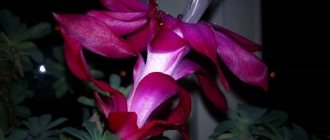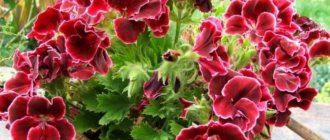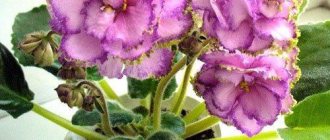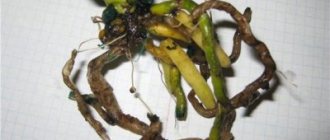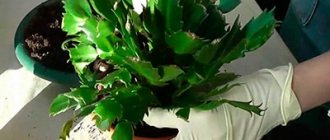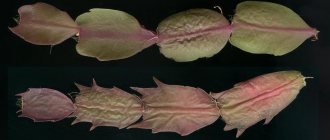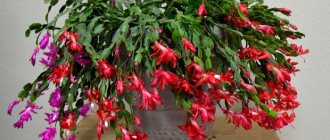Do not overfill
It is necessary to avoid too much watering, as the plant does not like it and it will not bloom. If the Decembrist began to shed leaves, it means that it was overwatered. In this case, you can get by with simply spraying the soil and crown, which should be done once every 1.5-2 weeks. After flowering, a rest with limited watering will be required as it will produce buds again much faster this way.
Decembrist: care at home
Decembrist care varies depending on the season. During the year, this plant goes through several periods. Let's call them like this:
- Growing season – from mid-March to September;
- The first dormant period (preparation for flowering) is October;
- Flowering period – November – January;
- The second dormant period is February - mid-March.
Let's look at the rules for caring for Schlumbergera in each of these periods.
Growing season – from mid-March to September
During this period, the Decembrist flower is experiencing a time of active growth. It is growing in size and expanding into new segments. At this time, the plant can be kept on a ventilated windowsill, balcony or in the yard. Best of all - in the fresh air, in the thin shade of trees.
In the summer, Schlumbergera is regularly sprayed with warm water and watered as the earthen clod dries out. Under no circumstances should you overfill! Schlumbergera is prone to rotting at the slightest overwatering.
Caring for Schlumbergera at home in the summer includes fertilizing with nitrogenous or universal fertilizers once every 2 weeks.
The ideal summer temperature for zygocacti is 20-23°C.
In summer, it is better to take Schlumbergera out onto a balcony, loggia, veranda or courtyard. During the growing season, light and fresh air are very important for the plant.
Dormant period (preparation for flowering) – October
During this period, the plant gains strength before flowering and begins to lay flower buds. Whether it will bloom this year or not will depend on how well you care for the Decembrist plant in October.
In October, Schlumbergera needs less moisture and daylight hours. On the contrary, there should be more coolness and fresh air. Optimum temperatures for autumn keeping are 10-18°C.
If Schlumbergera was on the balcony or in the open air in the summer, if there is no frost, do not bring it into the apartment until November. Let it freeze - this promotes the formation of flower buds. Optimum temperatures for autumn keeping are 10-18°C. Schlumbergera also tolerates short-term temperature drops down to 3-5°C.
During this period, Decembrist should be watered rarely. Only when the leaf segments begin to shrink and lose turgor. Watering is best done not with water, but with brewed tea. A huge secret of flower growers: the Decembrist produces more flower buds from tea than from expensive fertilizer. According to some reports, after such “tea ceremonies” even problematic, never-blooming Decembrists bloom.
Closer to November, be sure to feed Schlumbergera with fertilizer for flowering plants - this will also promote long and abundant flowering.
Flowering period – November – January
At the end of October or early November, the Decembrist is brought into a warmer room (if the plant was on the windowsill, nothing is changed). The plant begins to be watered abundantly (preferably with warm brewed tea), and potassium-phosphorus fertilizer is applied. To form strong buds, Decembrist is watered with a solution of calcium nitrate or an infusion of eggshells. The infusion is made as follows: eggshells (raw) are washed, filled with water, left for a day and used for watering.
After about a week, buds begin to form. Optimal temperatures for flowering are 19-22°C during the day and 15-20°C at night.
During budding and flowering, you cannot turn the pot with Decembrist in relation to the light. It is best not to touch the plant at all, do not move it from place to place, or wash it.
Schlumbergera blooms can last until January
Rest period – February-March
After flowering, the Decembrist plant is formed, that is, the upper segments on the shoots are unscrewed. This stimulates good branching and the formation of a dense bush.
During the dormant period, Schlumbergera is watered after the top layer of the earthen clod has dried, and excessive drying is not allowed.
Choosing a pot and soil
When replanting, you will need to choose a new container and use fresh soil, since the old one is most likely salted and is not suitable for further cultivation of the Decembrist. The new pot should be no more than 2 centimeters wider than the previous one and the same amount deeper. This space will be enough for a year so that the flower can actively grow and build up its root system. The container can be made of plastic or clay, the main thing is that there are drainage holes at the bottom.
A container that is too large will hold a lot of water, which can cause root rot. In a small one, the Decembrist will stop growing. Before replanting the plant, you will need to disinfect the pot by soaking it in a solution of 1 part chlorine bleach and 9 parts water. After this, the container must be rinsed well with clean water.
As for the soil, there are special requirements for it: it must be light, nutritious, and acidic (with a pH of 5.5-6). High-quality drainage is a prerequisite for maintaining most indoor plants, and the Decembrist was no exception. If you purchase ready-made soil, it is best to buy a universal type of soil and one specialized for cacti, and then mix them in a 1:1 ratio. If you use only one type of soil, the flower will lack nutrients.
The plant is very susceptible to bacterial and fungal infections, so the soil should be moderately moist, preferably loose. As drainage you can use:
- pebbles;
- sphagnum;
- crushed stone;
- clay shards;
- gravel.
The foam crumble provides additional protection for the roots from hypothermia, but it cannot be used in large quantities, since it will hold back water rather than let it through. Additives such as perlite and vermiculite are no less in demand for drainage. Any drainage should be one third of the volume available in the container.
You can make your own soil mixture; there are several recipes for this. A soil made from sheet soil, coarse sand, peat and charcoal mixed in equal proportions is excellent. It will not damage turf or humus, which will become an excellent nutritional base. In another option, the ideal soil for a flower is collected from part of fertile soil, the same amount of sand and two parts of peat. Perlite gives the compost a loose feel.
Possible problems
Propagation of zygocactus by cuttings gives a high percentage of rooting, but problems may arise with the young plant:
- The leaf segments turn yellow and wither - perhaps the plant is in direct sunlight.
- Wilting of the cutting is a manifestation of a fungal infection or improper care. Excessive watering and the use of cold water lead to rotting of the roots. One of the causes of the disease is excess fertilizer. In this case, it is necessary to replace the substrate.
Where does Decembrist grow and why is it associated with hummingbirds?
Decembrist grows naturally in South America, but mostly in Brazil. However, these species differ from the domestic Schlumbergera because they prefer epiphytic symbiosis with various plants of the tropical evergreen forest, they connect with their trunks or root systems.
If you look at the photo of Decembrist flowers, you can note their beautiful flowering, thanks to this, flower growers really like to keep the plant at home. Externally, it is worth noting characteristics similar to a shrub: many segmented leaf-shaped or triangular shoots based on a soft texture with a length of up to 0.5 m. During the flowering period, it is their upper part that is covered with flowers 5-8 cm in size and a multi-tiered corolla system similar to a star with protrusion of stamens.
The flowers have too long a tube, so pollination is possible only for tiny birds of the hummingbird family. For this work, they have at least 6-8 weeks until the buds fully open. After this, the beauty of the flowers lasts for 4-5 days, then they fade.
Interesting fact: Decembrist is often confused with Hatiora because they have similar flowers and are similar in DNA structure.
